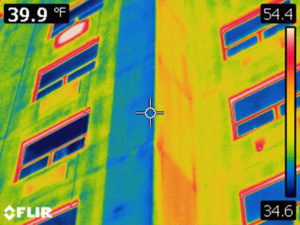Washington DC’s Clean Energy Act and Your Building Envelope


In January of 2019, Washington DC passed the Clean Energy DC Omnibus Act, setting energy standards and goals for the District. The bill is regarded as an ambitious environmental objective aimed to reduce greenhouse gas emissions and energy inefficiencies. Due to the fact that the majority of greenhouse gas emissions within Washington DC originate from existing institutional, commercial and even residential buildings, the impact of this new bill will largely affect building and property owners as the responsibility to sustainability improve these facilities will be assigned to them.
The Clean Energy Act calls for a reduction of greenhouse gas emissions of 50% by 2032. As part of that objective, the D.C. Department of Energy and Environment (DOEE) is establishing a standard that existing facilities must meet, which will be (at a minimum) the current median Energy Star score for D.C. buildings dependent on the property type and size. This suggests that half of D.C.’s buildings could require upgrades. This Building Energy Performance Standard (BEPS) for existing buildings is set to be fully defined by January 1, 2021.
This standard mandates buildings within the District to be evaluated and upgraded accordingly to meet the prescriptive energy performance requirements. For District-owned buildings of at least 10,000 square feet and private buildings of 50,000 square feet or more, the DOEE will assess the structures to be compliant to the performance standard. These energy performance assessments are to be completed on a 5-year basis, beginning in 2021. The ‘umbrella’ of private facilities subject to these standards will also gradually increase: in 2023, privately-owned buildings of at least 25,000 square feet will be held to this standard and private buildings of 10,000 square feet or more in 2026.
Should buildings fail to meet the standards set for by the DOEE, a 5-year window is allotted to the property owner to make the required upgrades to reduce site energy use by 20% or otherwise be cited for violations. An alternative prescriptive set of measures set by the DOEE will also be available to make the building more energy-efficient.
So what does all this mean for your building envelope?
While most would instinctively attribute building energy inefficiencies to outdated HVAC/mechanical equipment, the building envelope is a critical building system that drastically affects your energy consumption. The exterior walls, roofing assemblies, and other exterior building components are the primary defense system between the indoor controlled environment and the outside world. A poorly designed or maintained building envelope can have a complicated series of thermal inefficiencies that not only contribute towards costly energy bills but could also keep your building above the threshold set by the new DC Clean Energy Act. It’s more important than ever for DC building owners to understand their energy consumption as it relates to their building envelope.
BECS offers an extensive set of services that may help assess and improve a building’s energy performance. From outdated windows, insufficient roof insulation, or discontinuous air-weather barriers and more, BECS professionals can perform assessments, hygrothermal modeling, and on-site envelope testing to properly diagnose and address the most vulnerable parts of your building’s exterior. Please do not hesitate to contact us for any inquiries about your building’s energy performance and how it can be improved.
Resources:
https://dcclimate.org/wp-content/uploads/2018/12/DC-Climate-Omnibus-Bill-Fact-Sheet.pdf
https://ggwash.org/view/71751/dc-passed-the-most-ambitious-clean-energy-law-in-the-us-now-what

